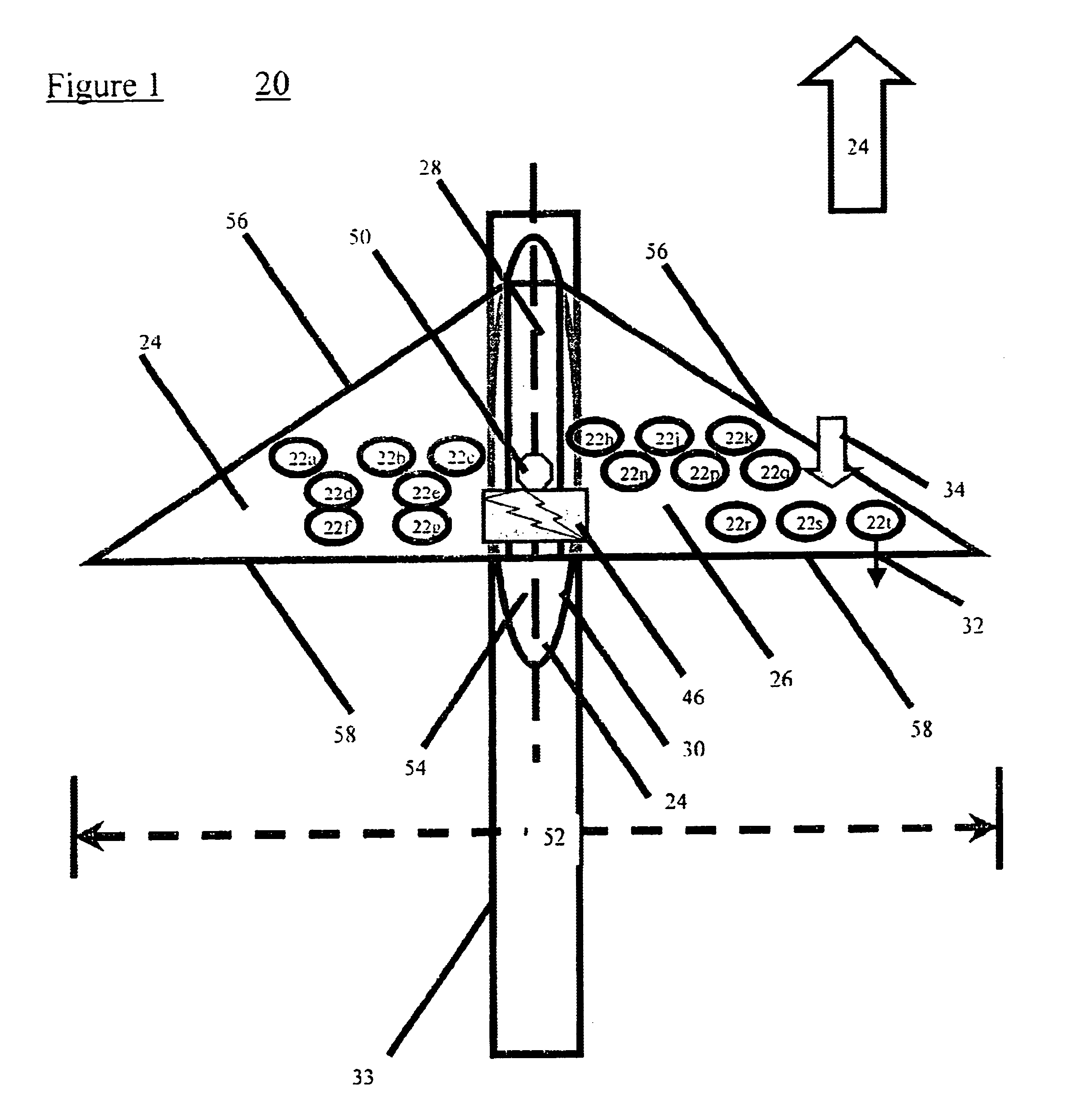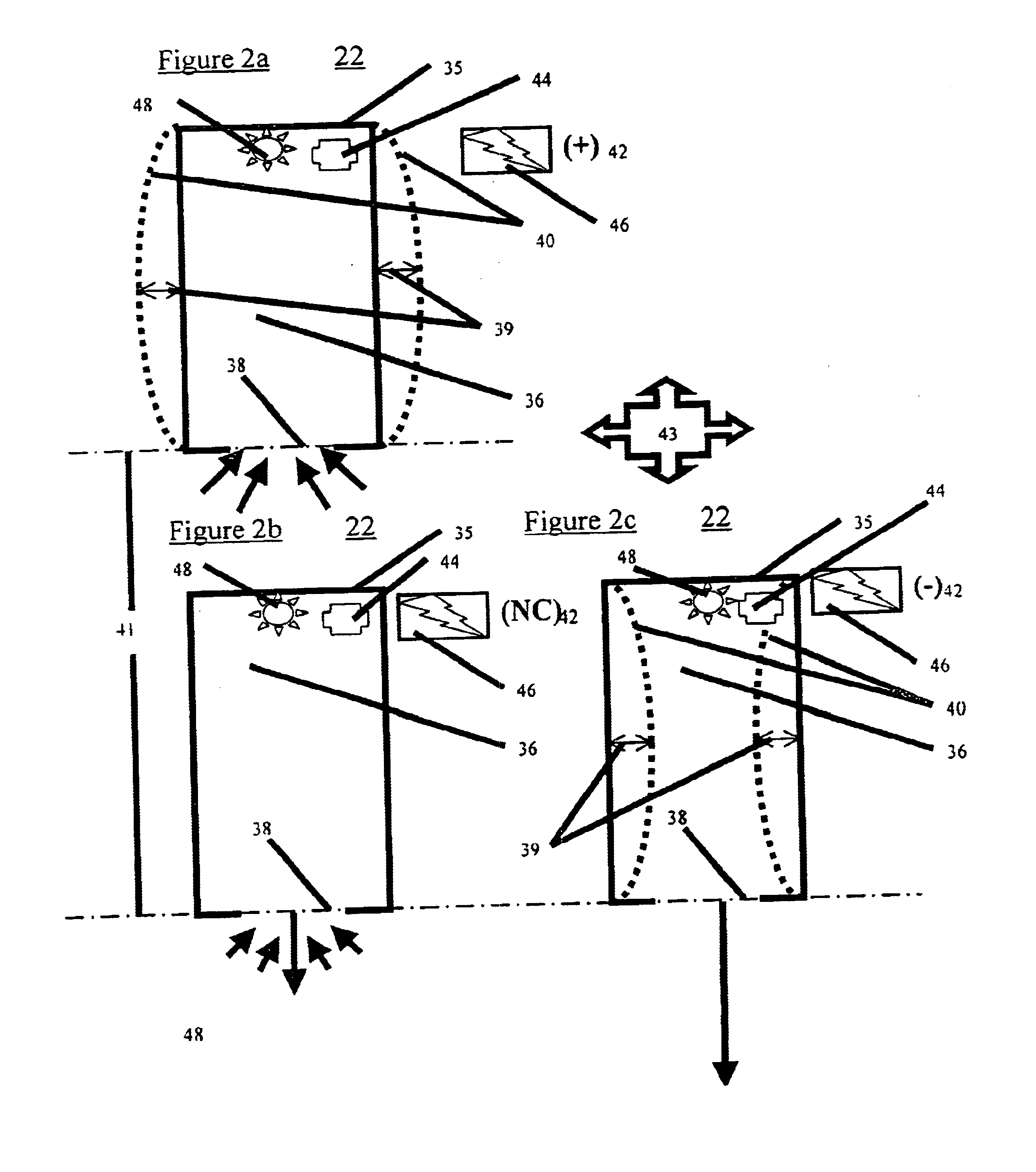Aerial vehicle controlled and propelled by oscillatory momentum generators and method of flying a vehicle
a technology of oscillatory momentum and generator, applied in the field of aircraft, can solve the problems of large and significant loss of efficiency, unsuitable application of these principles to miniaturized aircraft, and high cost of uav,
- Summary
- Abstract
- Description
- Claims
- Application Information
AI Technical Summary
Benefits of technology
Problems solved by technology
Method used
Image
Examples
example 1
Effects of Weight and Aspect Ratio
In order to illustrate basic aerodynamic advantages of a mUAV according to the present invention, consider estimates of Reynolds number, C.sub.L and thrust required (T.sub.R) as functions of flight speed (V), presented in FIGS. 6a-c respectively.
For purposes of comparison, the figures show calculations for three different configurations;
1) a conventional prior art mAV (weight W=0.1 kg, wing-span WS=0.15 m and aspect ratio AR=1; specifications approximately correspond to Lockheed Martin's MicroSTAR)
2) a light mUAV according to the present invention (i.e. WS=0.45 m, AR=4; W=0.225 kg)
3) a heavy mUAV according to the present invention (i.e. WS=0.45 m, AR=4; W=0.45 kg)
For all configurations, typical flight speeds are assumed to be approximately between 5 m / s and 25 m / s (see e.g. Spedding. and Maxworthy (1986) J. Fluid Mech., Vol. 165, pp. 247-272). FIG. 6a shows that the larger mUAVs are subjected to lower Reynolds numbers, for the flight speeds consider...
example 2
Theoretical Considerations in Predicting Flight Characteristics
The following equations present the method used for generating the curves in FIG. 6c (Adapted from Anderson (Ibid)) as well as all assumptions invoked.
A force balance shows that for level steady flight: ##EQU1##
where T and W are thrust and weight respectively. Therefore, the thrust required (T.sub.R) by the AFC devices employed in the present invention, for example, to overcome the total aircraft drag is ##EQU2##
Thus, for a given velocity, the lift coefficient is calculated from ##EQU3##
Therefore it is possible to calculate the total drag of the aircraft, i.e. ##EQU4##
where C.sub.D0 is the zero-lift parasite drag (typically 0.02 to 0.025 for conventional aircraft), e is the Oswald efficiency factor (usually .apprxeq.0.8 for conventional aircraft) and AR is the aspect ratio. It should be noted that C.sub.D0 for the mUAVs according to the present invention are lower since the aircraft is free of wing-body junctions, engine...
example 3
Previous Active Flow Control Limitations
Previously, it has been generally accepted that airfoil performance is significantly degraded below Re.about.O(10.sup.5). Further successive degradation occurs at Re=84,000 and 42,000, where many airfoils fail to generate useful lift.
Using an airfoil, originally designed as a flap (FIG. II.4a Now FIG. 7a), with chord length c=109 mm and maximum thickness (t / c).sub.max =17% (see Greenblatt, D. and Wygnanski, I., "Use of Periodic Excitation to Enhance Airfoil Performance at Low Reynolds Numbers" AIAA Journal of Aircraft, Vol. 38, No. 2, 2001, pp. 190-192.). The pictured airfoil has an interior plenum in fluid communication with a nominally two-dimensional, leading-edge slot (h=0.5 mm at x / c=2%) and is equipped with 18 surface pressure taps located on the center-span. Static and dynamic pressure measurements were made for 30,000.ltoreq.Re.ltoreq.150,000 at baseline and controlled conditions. Zero net mass-flux excitation (alternating air intake a...
PUM
 Login to View More
Login to View More Abstract
Description
Claims
Application Information
 Login to View More
Login to View More - R&D
- Intellectual Property
- Life Sciences
- Materials
- Tech Scout
- Unparalleled Data Quality
- Higher Quality Content
- 60% Fewer Hallucinations
Browse by: Latest US Patents, China's latest patents, Technical Efficacy Thesaurus, Application Domain, Technology Topic, Popular Technical Reports.
© 2025 PatSnap. All rights reserved.Legal|Privacy policy|Modern Slavery Act Transparency Statement|Sitemap|About US| Contact US: help@patsnap.com



